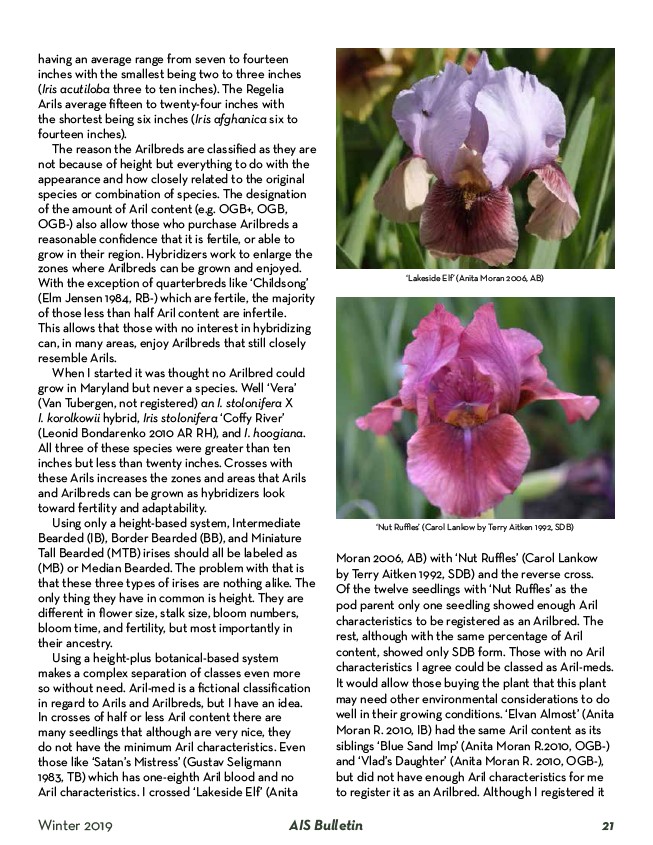
having an average range from seven to fourteen
inches with the smallest being two to three inches
(Iris acutiloba three to ten inches). The Regelia
Arils average fifteen to twenty-four inches with
the shortest being six inches (Iris afghanica six to
fourteen inches).
The reason the Arilbreds are classified as they are
not because of height but everything to do with the
appearance and how closely related to the original
species or combination of species. The designation
of the amount of Aril content (e.g. OGB+, OGB,
OGB-) also allow those who purchase Arilbreds a
reasonable confidence that it is fertile, or able to
grow in their region. Hybridizers work to enlarge the
zones where Arilbreds can be grown and enjoyed.
With the exception of quarterbreds like ‘Childsong’
(Elm Jensen 1984, RB-) which are fertile, the majority
of those less than half Aril content are infertile.
This allows that those with no interest in hybridizing
can, in many areas, enjoy Arilbreds that still closely
resemble Arils.
When I started it was thought no Arilbred could
grow in Maryland but never a species. Well ‘Vera’
(Van Tubergen, not registered) an I. stolonifera X
I. korolkowii hybrid, Iris stolonifera ‘Coffy River’
(Leonid Bondarenko 2010 AR RH), and I. hoogiana.
All three of these species were greater than ten
inches but less than twenty inches. Crosses with
these Arils increases the zones and areas that Arils
and Arilbreds can be grown as hybridizers look
toward fertility and adaptability.
Using only a height-based system, Intermediate
Bearded (IB), Border Bearded (BB), and Miniature
Tall Bearded (MTB) irises should all be labeled as
(MB) or Median Bearded. The problem with that is
that these three types of irises are nothing alike. The
only thing they have in common is height. They are
different in flower size, stalk size, bloom numbers,
bloom time, and fertility, but most importantly in
their ancestry.
Using a height-plus botanical-based system
makes a complex separation of classes even more
so without need. Aril-med is a fictional classification
in regard to Arils and Arilbreds, but I have an idea.
In crosses of half or less Aril content there are
many seedlings that although are very nice, they
do not have the minimum Aril characteristics. Even
those like ‘Satan’s Mistress’ (Gustav Seligmann
1983, TB) which has one-eighth Aril blood and no
Aril characteristics. I crossed ‘Lakeside Elf’ (Anita
‘Lakeside Elf’ (Anita Moran 2006, AB)
‘Nut Ruffles’ (Carol Lankow by Terry Aitken 1992, SDB)
Moran 2006, AB) with ‘Nut Ruffles’ (Carol Lankow
by Terry Aitken 1992, SDB) and the reverse cross.
Of the twelve seedlings with ‘Nut Ruffles’ as the
pod parent only one seedling showed enough Aril
characteristics to be registered as an Arilbred. The
rest, although with the same percentage of Aril
content, showed only SDB form. Those with no Aril
characteristics I agree could be classed as Aril-meds.
It would allow those buying the plant that this plant
may need other environmental considerations to do
well in their growing conditions. ‘Elvan Almost’ (Anita
Moran R. 2010, IB) had the same Aril content as its
siblings ‘Blue Sand Imp’ (Anita Moran R.2010, OGB-)
and ‘Vlad’s Daughter’ (Anita Moran R. 2010, OGB-),
but did not have enough Aril characteristics for me
to register it as an Arilbred. Although I registered it
Winter 2019 AIS Bulletin 21